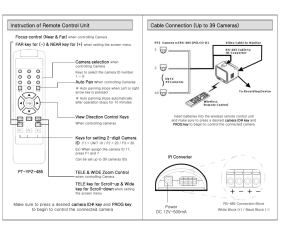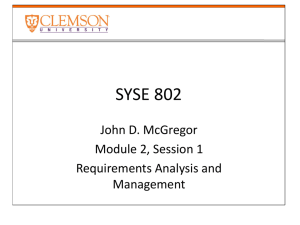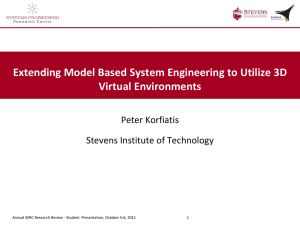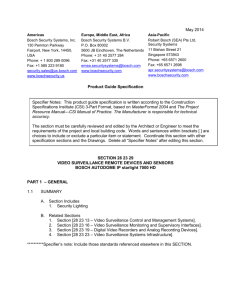Hopkins APL Closed Circuit TV Video Integration Project
advertisement
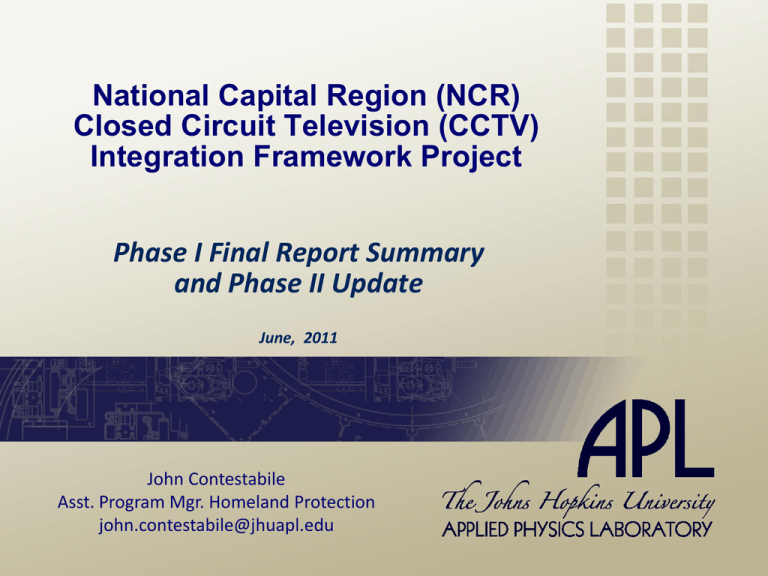
National Capital Region (NCR) Closed Circuit Television (CCTV) Integration Framework Project Phase I Final Report Summary and Phase II Update June, 2011 John Contestabile Asst. Program Mgr. Homeland Protection john.contestabile@jhuapl.edu Agenda • Nature of the video sharing problem • Project Overview / Team / Statement of Work / Study Participants • Study Accomplishments • Conceptual Interoperability Model / NCR Application • Video Sharing Ground rules • Recommended “To Be” Architecture • Recommended “To Be” Security Concept • Future / Follow on Recommendations • Next Steps 2 Nature of the Video sharing Problem • • • • • • • No policy or CONOPS for sharing Video ownership and permissions to access issues Permission to control Pan/tilt/zoom of the camera No common network to access the video Varying video formats that cannot be viewed by others Varying bandwidth and file size issues Limits on number of users that can access a particular camera feed without “crashing” the system • Most systems designed to “aggregate” video within an agency, not share it outside the agency 3 Video Project Overview Goals: • Interoperability – able to share video images • Develop a Concept of Operations (CONOPS) with the practitioners • Provide strategic direction for future video system investments Critical Success Factors: • Operating procedures to define and facilitate video sharing • Technical Framework to enable video sharing • Strategy and resources to implement and maintain a video sharing system. Phase I study to investigate the problem and recommend a way forward (completed March, 2011) Phase II to implement the proposed architecture between the regional Departments of Transportation (to be completed this summer) 4 Project Sponsor, Manager and Partners Project Sponsor • NCR Critical Infrastructure Protection Working Group Project Manager • DC Homeland Security and Emergency Management Agency Project Partners • Johns Hopkins University Applied Physics Laboratory • SkyLine Network Engineering, LLC & Earth Security Electronics, LLC 5 Review Statement of Work Five Tasks: • • • • • 6 Task 1: Finalize Conceptual Project Plan - Hold stakeholder meetings to identify a subset of CCTV systems that represent the region geographically, technologically, jurisdictionally and by discipline. Completed in April 2010 Task 2: Conduct Video Systems Inventory - Develop data collection strategy, identify camera locations with GPS coordinates and retain in a database, and develop GIS presentation of the data. Completed in July 2010 Task 3: Conduct Data Analysis - Identify camera coverage gaps, document “As Is” architecture, develop “To Be” video sharing alternatives, and provide illustrative ROM cost estimates to migrate. Completed October 2010 Task 4: Develop Concept of Operations (CONOPS) – Review policies, standard operating procedures, and any existing CONOPS. Work with participant stakeholders to develop a draft video sharing CONOPS. Completed by November 2010. Phase I final draft report completed December, 2010 Task 5: Additional Systems Integration (optional) - Include additional cameras or systems into the framework as requested. Tasked to build a prototype system between the regional transportation agencies. Initiated December 2010 through August 2011 Study Participants • • • • • • • • • • • • • • • • • • • 7 Arlington County DC Homeland Security and Emergency Management Agency (HSEMA) Fairfax County (Department of Police) Maryland Department of Transportation (MDOT) Maryland State Police Maryland State Highway Administration (SHA) Maryland Transportation Authority (MdTA) Metropolitan Washington Airports Authority (MWAA), National and Dulles Airports Montgomery County Department of Police Montgomery County Department of Transportation Prince Georges County United States Park Police Virginia Department of Transportation (VDOT) Washington Metropolitan Area Transit Authority (WMATA) Washington Suburban Sanitary Commission Capital Wireless Information Net (CapWIN) * Fairfax County Data Exchange Hub (DEH) * FEMA Office of National Capital Region Coordination * Maryland Coordination and Analysis Center (MCAC) * *indicates video consumer only Study Accomplishments Developed camera inventory of participating agencies Produced a Concept of Operations for video sharing Developed a map based display of cameras Developed “As Is” and proposed “To Be” video sharing architecture Developed a security framework for sharing video images Develop order of magnitude cost estimates for implementation of the “To Be” architecture 8 Conceptual Interoperability Model 9 NCR Adaptation of the Conceptual Interoperability Model 10 By: Twyla Garrett circa 2005 Video Sharing Ground Rules Overall Ground Rules • Video sharing must be both horizontal and vertical • The new system should support any sharing currently in place • The new system should initially support real-time video sharing to various centers, who may then provide it to first responder/field units (i.e. Emergency Management Agencies, Fusion, and Operations Centers) 11 Video Sharing Ground Rules Source Agency • Decides what to share • Video Remains under their control • Exclusive Property, right to record, retention policy • Determines Security Level for each Video • Determines Permissions to see video • Retains Pan/Tilt/Zoom (PTZ) camera control • Ability to disable video feed or feeds to Receiving Agencies, based on Security level or user group • Should not require major modifications to the current video systems Receiving Agencies (Viewing Agencies) • May request stored images from Source Agency • May retain or share only with Permission from Source Agency • MOU needed for recording video of source agency when they do not • May request Agency to record images • May request PTZ movement 12 Existing “AS IS” Video Sharing Capability The current “As Is” architecture of the participating agencies has traditionally been limited to a combination of video sharing at the Data and Presentation Layers. These methods have been successful for the short term and on a small scale, but have been very expensive and difficult to implement. As we look towards a regional architecture for video sharing these current methods will need to be replaced with a more efficient and network friendly approach. 13 Potential Types of Video Sharing • Presentation Layer video sharing requires expensive infrastructure investment, distributes control, creates network security issues, and typically requires each connection to be a custom design. The user will typically have separate workstations for each application. • Data Layer video sharing allows for direct access to the video source, but increases the need for expensive, high bandwidth networks. Sharing at this level may also necessitate camera licenses for every camera connection, require extensive firewall rules, lead to major scalability issues, and require the source data to be a particular type of feed leading to the expense of new equipment. • Physical Security Information Management (PSIM) video sharing is a combination of the Presentation Layer and Data Layer models. This technique, while applicable to a limited number of EOCs, multiplies the issues of connectivity costs, network security, source control, and network bandwidth needs if applied regionally. 15 Recommended “TO BE” Video Sharing Concept Utilize a Layered Approach • Interoperability is achieved in the Integration Layer • Normalize the data • Distribute the data utilizing a Secure Architecture • Allow Data to be viewed in each Agency’s current Presentation Layer Application 20 21 22 Recommended “TO BE” Video Sharing Concept 23 Pros: Cons: • Provides Agency with source control and the ability to create multiple security domains • Camera and Intranet are only accessed once • Firewall Friendly • Eliminates Vendor Dependence • Allows Agencies freedom to choose VMS and Presentation Applications that meets their needs • Highly scalable • Low Bandwidth impact • Ability to share with Mobile devices • Ability to create instant access to video • No Client needed to see the video • Ability to Adjust Stream Bandwidth • Ability to Change Stream Output • Comparable Cost is low • Additional Configuration needed to extend PTZ control • Limited Access to Video Archives Recommended “TO BE” Video Sharing Security Concept Four Video Security Levels, set by the owning agency. • Level 1 – Open access to partners - public/no MOU needed • Ex. Highway Traffic video, public parking areas • Level 2 – Open access to partners/regional MOU needed • Ex. Rail platform video, lobbies, plazas • Level 3 – Restricted access to partners/agency specific MOU needed • Ex. Views of non-public areas, internal building video • Level 4 – LEO only/restricted access/agency specific MOU needed • Ex. Surveillance video, screening areas, possibly encrypted 24 Recommended “TO BE” Video Sharing Security Concept Four User Security Levels, set by the owning/receiving agencies. 25 • Level 1 - Unlimited Access at the owning agency Unlimited Access at the receiving agency • Level 2 - Unlimited Access at the owning agency Unlimited Access at the receiving agency • Level 3 - Unlimited Access at the owning agency Access controlled by user ID/password or authentication at the receiving agency • Level 4 - Access controlled by the owing agency Generally no access except by MOU, controlled by user ID/password or authentication at the receiving agency Phase II Next Steps • Under “Optional Task 5”, Implement the “To Be” video sharing architecture between the regional transportation agencies (i.e. VDOT, DC DOT, MDOT/SHA) Sub Task 1 – Review Architecture with the transportation agencies in light of existing and proposed systems Sub Task 2 – Develop proposed systems design(s) and cost estimate(s) Sub Task 3 – Implement the selected proposed system design • Additional ‘08 UASI Funding - $200,000 • Period of performance – December 2010 to August 2011 26 Phase II Next Steps Demonstration 27 Phase III - FY 2011 UASI Follow on Project - $740K • Expand the DOT pilot architecture to other partners (particularly MWAA and WMATA)…to include hardware • Integrate map based display of cameras with regional GIS systems (i.e. VIPER/EMMA/iSAVE/vUSA ) and other data sets • Develop systems documentation (i.e. DEH/NCRnet) as well as a long term governance and sustainment plan in association with the CIO Committee • Refine security framework based on implementation of the “To Be” architecture • Develop a plan for Private Sector participation in regional video sharing 28 Questions? • Many thanks to All who participated in this study! John Contestabile Johns Hopkins University/Applied Physics Lab John.contestabile@jhuapl.edu 29 Additional Slides 30 NCR CCTV Project Inventory 31








